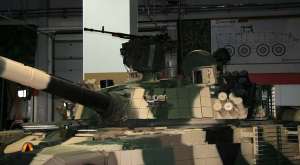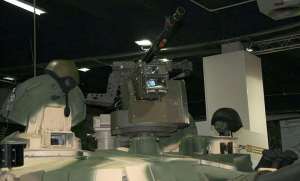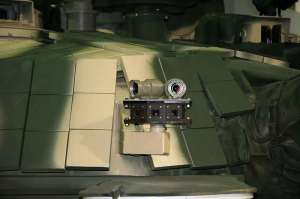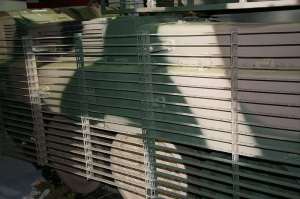| Designation: | PT-72U |
 |
|---|---|---|
| Manufacturer: | BUMAR LABEDY S.A. Zaklady Mechaniczne | |
| Product type: | Armoured Vehicles | |
| Name: | Main battle tank |
Polish concern Bumar Łabędy SA presents a package of equipment intended to increase the tankís survivability during operations in urban areas and in other asymmetric operation situations. The package was inspired by the consideration given by the Polish MoD to sending tanks to support the Polish Military Contingent (PKW) in Afghanistan and by the experience of other armies that operate tanks in such conditions. Eventually the PKW has not received tanks, but it is not impossible that it will receive them in the future, to cover the process of withdrawal from Afghanistan. Exports orders are also possible. T-72 tanks are still one of the most numerous tanks in armies worldwide, so the package is promoted under the name of PT-72U, to stress the possibility to use it on various derivatives of the original vehicle. Similar packages have been prepared for most western tank types, such as the M1 Abrams, Leopard 2, or AMX-56 Leclerc.
Engineers from Łabędy have focused on correcting the shortcomings of the T-72 tank family design, such as the low elevation of the main armament, high vulnerability of the tank commander when manning the anti-aircraft machine gun, poor situation awareness caused by obsolete means of omnidirectional observation, or poor resistance of side and rear armour against light anti-tank weapons such as RPG-7 grenade launchers.
The most visible part of the upgraded tank is the openwork screening protecting all surfaces of the tank that are not covered with reactive armour, such as the sides and rear of the hull and turret. The screens are positioned 500-700 mm away from the main armour, to allow effective dissipation of the penetrating jet. The armour was developed by Bumar-Łabędy in cooperation with the Department of Mechanics and Applied IT of WAT. This seemingly unimportant and not very advanced element could be important for tankís survival in urban combat. This can be illustrated with the destruction of a Georgian T-72 tank during the attack on Tskhinvali on 8 August 2008. The shaped charge missile fired from a handheld anti-tank grenade launcher hit the middle of the rear armour of the turret, the penetrating jet perforated the relatively thin armour and hit a 125 mm round in the tankís gun loader, resulting in its explosion and blowing away the turret. Had the Georgian tank been fitted with a device similar to the openwork armour from the PT-72U package, results of that hit would not have been so tragic. The solution is the more usable as there is only minimal increase in the tankís weight: the armour kit weighs only 420 kg (170 kg for the turret and 250 kg for the hull).
Trap mines are one of principal threats in asymmetric conflicts. Engineers from Łabędy and WAT have increased the protection level offered by the tank against this danger. To thsi end the driver will have a seat attached to the upper hull, and forward portion of the hull will have an Energy-absorbing Bottom Panel made from composite materials.
Another visible element is to replace the 0.5 in. (12.7 mm) anti-aircraft machine gun operated manually by the commander with the ZSMU-127 Kobuz remote controlled weapon station (RCWS) from ZM Tarnów. The station is completely autonomous from the tankís FCS and has its own set of observation-sighting devices. Its horizontal field of fire is 360o, with elevations of -5o to +55o (it is worth reminding here that the same data for the main gun of the T-72 tank is merely -5.5o to +14o). USing the station improves the tankís ability to hit targets, and this could be of critical importance during urban fighting.
The RCWS is complemented by the ODR-HV ODF Optronics omnidirectional observation system. The system includes a set of eight daylight TV cameras covering full 360o (the system is served by 24 cameras at most) and the ODR PTZ rotating head with a thermal vision camera, the central unit and a touch-screen control panel. The rotating head can turn 360o in horizontal, its elevation range is -10o to +70o, and it can apply up to 26x optical zoom. When static, the system can detect movement and optionally automatically direct the RCWS towards the potential threat. The ODR PTZ device was fitted in the forward section of the tank between the hatches of the commander and the gunner, while the TV cameras of the ODR-HV system are on the sensors of the OBRA-3 system, on the tank turret (three cameras on the left side of the turret, two on the right and three at the rear, on the basket).
The above listed systems are complemented by an item that is not directly linked with asymmetric operations but it significantly improves the crew comfort and cost-effectiveness of the vehicle, the auxiliary power unit (APU). The APU was used already in the PT-91M tanks for Malaysia. The 17 kW power unit was developed in cooperation with ESW-Jenoptik GmbH, based on a Perkins diesel engine. Apart from supplyiung energy to vehicle systems when stopped, it can also supply power to the air conditioning (A/C) system (as opposed to the tanks for Malaysia, the A/C compressor system was changed from mechanical to electric, allowing the A/C system to be powered from any source, but just the aggregate). Notably, fitting the A/C system has only necessitated to reduce the second stage ammunition establishment by a mere single shell and its cartridge. This should not be a major problem as experience from the conflicts in Chechnya and Georgia tend to show that during urban fighting the ammunition establishment should be limited to just the first stage already in the automatic loader.
The communication system was also upgraded by fitting a modern Radmor RRC9310AP radio set, Fonet-IP intercom system and Trop battlefield management system. The Fonet system is fitted with a high power external amplifying system and outer connection to the inter-com system.
Other changes included the new PRM-02 voltage stabiliser from Radiotechnika-Marketing, new microprocessor start-up unit for the main engine, an electronic panel with memory that replaces the driverís panel, an upgraded automatic loader control system (for example, the loader can rotate both ways, this reducing the loading time). The driverís panel and the upgrade of the automatic loader were developed in cooperation with Wasko.
The package is offered in versions for the T-72M1 (PT-72U), PT-91 (PT-91U), PT-91E (PT-91EU) and potentially for other tanks from the family. The package increases the tankís capabilities not just in irregular operations, but all other as well, which raises the value of those not-too-modern but still dangerous vehicles.
 |
 |
 |
 |
 |
 |
 |
